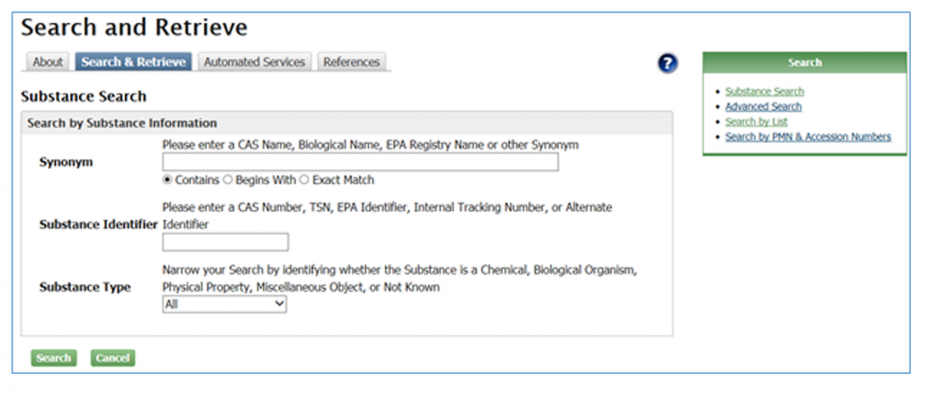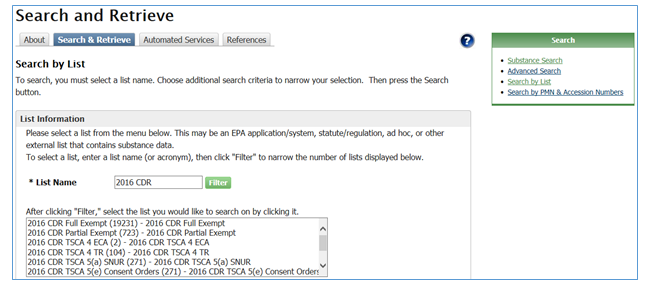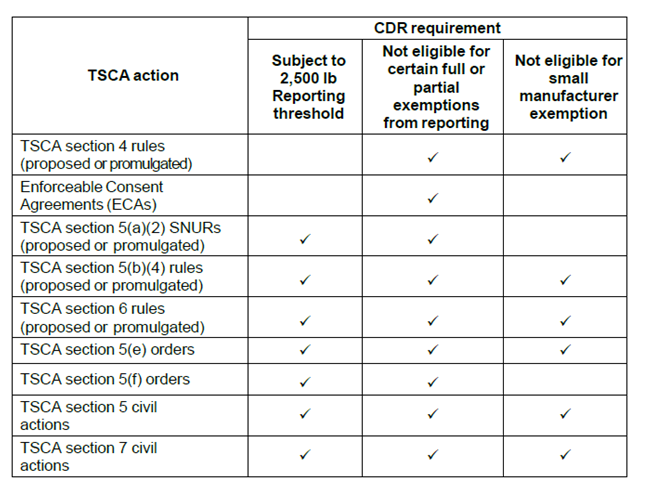Help with Chemical Data Reporting: How to Search for Chemicals Subject to Certain TSCA Actions
- What is SRS?
- How does the CDR reporting tool, e-CDRweb, use SRS?
- How do I search SRS for CDR-related information?
- For further information
- Appendix 1: TSCA Actions Table
This document contains instructions on how to identify chemicals that are the subject of certain actions under the Toxic Substances Control Act (TSCA) using the Substance Registry Services (SRS).
This may be important to you because, when reporting under the Chemical Data Reporting (CDR) rule, manufacturers (including importers) must consider the effect of certain TSCA actions on reporting thresholds and their eligibility for certain exemptions, and the SRS contains information that you can use to identify whether your chemical substances are impacted.
For more information also see TSCA Chemical Data Reporting Fact Sheet: Chemical Substances which are the Subject of Certain TSCA Actions
The primary goal of this document is to help the regulated community comply with the requirements of CDR. This document does not substitute for that rule, nor is it a rule itself. It does not impose legally binding requirements on the regulated community or on the U.S. Environmental Protection Agency (EPA).
The Substance Registry Services (SRS) is EPA’s central system for information about substances that are tracked or regulated by EPA or other sources. It is the authoritative resource for basic information about chemicals, biological organisms, and other substances of interest to EPA and its state and tribal partners.
How does the CDR reporting tool, e-CDRweb, use SRS?
When using e-CDRweb, submitters will be able to directly access information in SRS to add chemical identity information to CDR’s Form U. e-CDRweb uses an embedded SRS search function to access and search the SRS system. The embedded tool then populates selected chemical identity information into the CDR Form U. If your chemical is the subject of a TSCA action potentially affecting the scope of your reporting obligation, the e-CDRweb application should identify it as such.
You should check the status of your chemical substance(s) as of June 1, 2016. Whether or not your chemical substance is subject to CDR depends on its presence on the Master Inventory File at the beginning of a submission period, and the scope of your reporting obligation may also depend on whether your chemical substance is the subject of a listed TSCA action as of June 1, 2016. If it is, that could affect the reporting threshold or the availability of particular reporting exemptions that would otherwise apply. (40 CFR 711.5, 40 CFR 711.6, 40 CFR 711.8(b), 40 CFR 711.9) See appendix 1 for a table that summarizes the effect on reporting under CDR of certain TSCA actions.
How do I search SRS for CDR-related information?
To search SRS for chemicals that are subject to certain TSCA actions, you can search for either a specific chemical or you can search for a complete list of chemicals related to a type of regulation or other characteristic that affects the status of a chemical related to CDR. Chemical lists with titles that start with “2016 CDR” are specific to the 2016 CDR and will be frozen to reflect the status of chemicals as of June 1, 2016.
To search for a specific chemical:

- Type in a substance name in the “Synonym” field, a CASRN, or an accession number in the “Substance Identifier” field and select “Search.”
- Link to the chemical result that most closely meets your search needs.
- Select “Program and Regulatory Information.”
- Under “Statutes/Regulations,” look for chemical list titles that start with “2016 CDR” to see the statutes/regulations or other characteristics that affect reporting to the 2016 CDR.
To search for a list of chemicals that are related to a regulation or other CDR-related characteristic:
- Visit the SRS “Search and Retrieve” webpage.
- In the green “Search” box on the right side of the webpage, select “Search by List”.

- Select the chemical list that you would like to view and select “Search.” To see only 2016 CDR-specific lists, you can type “2016 CDR” in the “Filter” box and select “Filter.” The “2016 CDR” chemical list titles follow, along with a description (if necessary) and the corresponding “TSCA Action” or other CDR characteristic that was included in the table on page 3 of the CDR document “Fact Sheet: Chemical Substances which are the Subject of Certain TSCA Actions” (see Appendix 1 of this document for the TSCA Actions table):
- 2016 CDR TSCA Inv
- This is the full TSCA Inventory list.
- 2016 CDR Full Exempt
- 2016 CDR Partial Exempt
- 2016 CDR TSCA 4 TR
- This list contains chemicals on proposed and final TSCA section 4 test rules, minus any of those chemicals that have a sunset date that occurs before June 1, 2016, which is the first day of the 2016 Chemical Data Reporting (CDR) submission period. The CDR rule under TSCA requires manufacturers (including importers) to provide EPA with information on the production and use of chemicals in commerce at certain quantities every four years, and the reporting requirements for the 2016 CDR are based upon the status of the chemical – e.g., if the chemical is included in a TSCA section 4 test rule – on June 1, 2016.
- This list corresponds to “TSCA section 4 rules (proposed or promulgated)” on the TSCA Actions fact sheet.
- 2016 CDR TSCA 4 ECA
- This list contains chemicals in TSCA section 4 Enforceable Consent Agreements (ECA), minus any of those chemicals that have a sunset date that occurs before June 1, 2016, which is the first day of the 2016 Chemical Data Reporting (CDR) submission period. The CDR rule under TSCA requires manufacturers (including importers) to provide EPA with information on the production and use of chemicals in commerce at certain quantities every four years, and the reporting requirements for the 2016 CDR are based upon the status of the chemical – e.g., if the chemical is included in a TSCA section 4 ECA – on June 1, 2016.
- This list corresponds to “Enforceable Consent Agreements (ECAs)” on the TSCA Actions fact sheet.
- 2016 CDR TSCA 5(a) SNUR
- This list corresponds to “TSCA section 5(a)(2) SNURs (proposed or promulgated)” on the TSCA Actions fact sheet.
- 2016 CDR TSCA 5(e) Consent Orders
- This list corresponds to “TSCA section 5(e) orders” on the TSCA Actions fact sheet.
- 2016 CDR TSCA 5(f) Specific Labeling
- This list corresponds to “TSCA section 5(f) orders” on the TSCA Actions fact sheet.
- 2016 CDR TSCA 6 Unreasonable Risk
- This list corresponds to “TSCA section 6 rules (proposed or promulgated)” on the TSCA Actions fact sheet.
- Note that several of the lists that were referenced in the TSCA Actions fact sheet – “TSCA section 5(b)(4) rules (proposed or promulgated),” “TSCA section 5 civil actions,” and “TSCA section 7 civil actions” – would affect reporting requirements for CDR, except for the fact that EPA has no chemicals associated with those regulations as of the date of these instructions.
For further information:
Access copies of additional fact sheets and other CDR information.
If you have questions about CDR, you can contact the TSCA Hotline by phone at 202-564-1404 or e-mail your question to eCDRweb@epa.gov.
Appendix 1: TSCA Actions Table, taken from
Fact Sheet: Chemical Substances which are the Subject of Certain TSCA Actions

